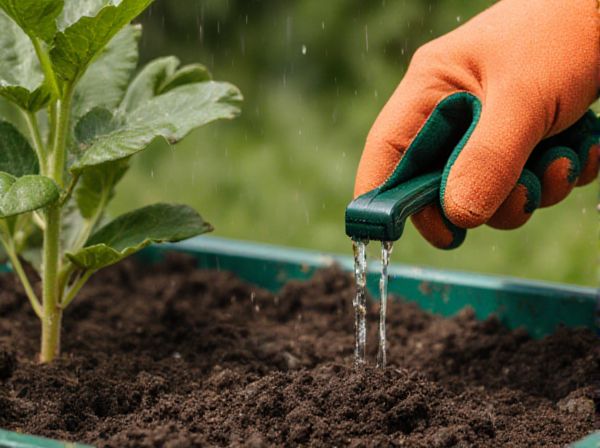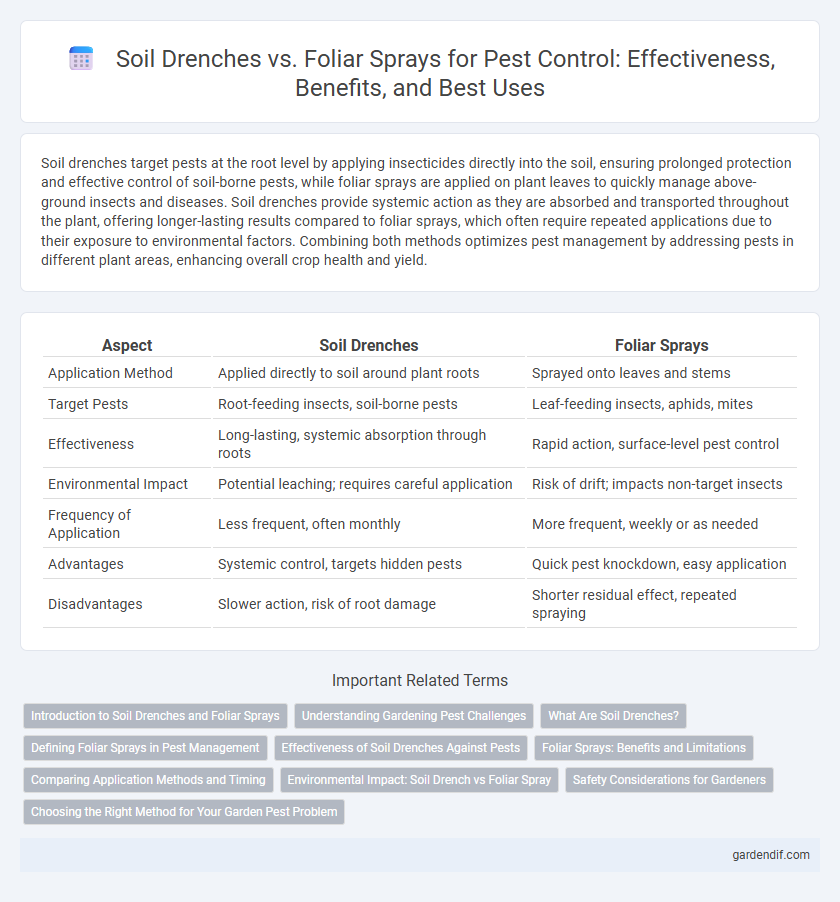
soil drenches vs foliar sprays Illustration
Soil drenches target pests at the root level by applying insecticides directly into the soil, ensuring prolonged protection and effective control of soil-borne pests, while foliar sprays are applied on plant leaves to quickly manage above-ground insects and diseases. Soil drenches provide systemic action as they are absorbed and transported throughout the plant, offering longer-lasting results compared to foliar sprays, which often require repeated applications due to their exposure to environmental factors. Combining both methods optimizes pest management by addressing pests in different plant areas, enhancing overall crop health and yield.
Table of Comparison
| Aspect | Soil Drenches | Foliar Sprays |
|---|---|---|
| Application Method | Applied directly to soil around plant roots | Sprayed onto leaves and stems |
| Target Pests | Root-feeding insects, soil-borne pests | Leaf-feeding insects, aphids, mites |
| Effectiveness | Long-lasting, systemic absorption through roots | Rapid action, surface-level pest control |
| Environmental Impact | Potential leaching; requires careful application | Risk of drift; impacts non-target insects |
| Frequency of Application | Less frequent, often monthly | More frequent, weekly or as needed |
| Advantages | Systemic control, targets hidden pests | Quick pest knockdown, easy application |
| Disadvantages | Slower action, risk of root damage | Shorter residual effect, repeated spraying |
Introduction to Soil Drenches and Foliar Sprays
Soil drenches involve applying pesticides or nutrients directly to the soil, allowing roots to absorb active ingredients for systemic pest control and improved plant health. Foliar sprays target insects and diseases on leaf surfaces through direct application of solutions, providing rapid and localized treatment. Both methods vary in effectiveness depending on pest type, environmental conditions, and plant species, making selection crucial for integrated pest management strategies.
Understanding Gardening Pest Challenges
Soil drenches deliver systemic pesticides directly to plant roots, targeting soil-dwelling pests and ensuring long-lasting protection by absorbing active ingredients into the vascular system. Foliar sprays provide immediate pest control on leaves and stems, effectively combating airborne and surface-feeding insects but often requiring repeated applications due to environmental factors. Understanding the specific pest types and infestation locations in the garden is crucial to choosing between soil drenches and foliar sprays for optimal pest management and healthier plant growth.
What Are Soil Drenches?
Soil drenches involve applying liquid pesticides or nutrients directly to the soil around plant roots, allowing for deep absorption and systemic protection against pests. This method targets soil-dwelling insects and root diseases more effectively than foliar sprays, which only cover the above-ground parts of plants. Consistent use of soil drenches can improve pest control by maintaining a protective barrier in the root zone, enhancing overall plant health.
Defining Foliar Sprays in Pest Management
Foliar sprays in pest management involve applying pesticides directly to the leaves and stems of plants for rapid absorption and targeted pest control. This technique ensures immediate contact with pests, reducing infestation levels effectively without affecting the soil ecosystem. Foliar sprays are especially useful for managing insect pests and diseases on crops with dense foliage, providing quick symptom relief and preventing further spread.
Effectiveness of Soil Drenches Against Pests
Soil drenches deliver active pest control agents directly to the root zone, ensuring systemic distribution throughout the plant and targeting soil-dwelling pests effectively. This method provides prolonged pest suppression by saturating the soil, thus reducing populations of nematodes, root aphids, and other subterranean insects. Unlike foliar sprays, soil drenches minimize pesticide drift and degradation, enhancing overall pest management efficiency.
Foliar Sprays: Benefits and Limitations
Foliar sprays deliver pesticides directly to plant leaves, enabling rapid absorption and targeted pest control, which enhances effectiveness against leaf-dwelling insects and fungal pathogens. Their benefits include quicker symptom relief and reduced environmental contamination compared to soil drenches. Limitations involve potential leaf damage under high concentrations and reduced efficacy during rainfall or high humidity, necessitating careful application timing for optimal results.
Comparing Application Methods and Timing
Soil drenches offer targeted pest control by delivering systemic insecticides directly to the root zone, allowing uptake through the plant's vascular system and providing long-lasting protection against soil-dwelling and stem-boring pests. Foliar sprays are effective for immediate pest knockdown on leaves and stems, ideal for managing phloem-feeding insects and fungal pathogens, but generally require frequent reapplication due to environmental factors like rain or UV degradation. Timing soil drenches during early growth stages ensures optimal systemic distribution, while foliar sprays should be applied at pest infestation onset or during active feeding periods for maximum efficacy.
Environmental Impact: Soil Drench vs Foliar Spray
Soil drenches typically have a lower environmental impact than foliar sprays because they reduce pesticide drift and minimize exposure to non-target organisms such as pollinators and beneficial insects. Foliar sprays can lead to greater off-target contamination of air, water, and adjacent ecosystems due to spray drift and runoff. Choosing soil drenches can enhance pest management sustainability by limiting chemical dispersion and supporting ecological balance in agricultural environments.
Safety Considerations for Gardeners
Soil drenches reduce direct pesticide exposure to gardeners by targeting pests in the root zone, lowering inhalation and skin contact risks compared to foliar sprays. Foliar sprays may pose greater respiratory hazards due to airborne droplets and require protective gear to prevent skin absorption. Prioritizing soil drenches can enhance safety while effectively managing soil-borne pest infestations.
Choosing the Right Method for Your Garden Pest Problem
Soil drenches deliver systemic pesticides directly to plant roots, providing long-lasting control for root-feeding pests like nematodes and grubs, while foliar sprays target above-ground insects such as aphids and caterpillars on leaves and stems. Selecting the appropriate method depends on the pest's location and behavior, with soil drenches preferred for subterranean infestations and foliar sprays for visible, surface-dwelling pests. Understanding the pest species and their life cycle ensures effective application, maximizing pest control efficacy while minimizing environmental impact.
soil drenches vs foliar sprays Infographic

 gardendif.com
gardendif.com